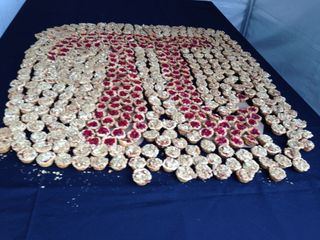
AUSTIN, Texas — It's an event that comes around just once in a century.
Math nerds and circle fans everywhere celebrated the "Pi Day of the Century" today, March 14, 2015, at 9:26 a.m. and 53 seconds. The date and time spelled the first 10 digits of pi: 3.141592653.
Revelers here at the 2015 South by Southwest (SXSW) Interactive festival celebrated the event with free mini-pi(e)s, selfies with giant pi symbols, and a countdown to the big moment. [See photos from the "Pi Day of the Century" event at SXSW]
Pi is the mathematical constant that represents the ratio of a circle's circumference to its diameter, and its decimal representation famously never ends and never repeats.
Though we all know the famous number as pi, it was actually only given its dessert-sounding name about 300 years ago, when William Jones, a Welsh mathematician, began initially using the symbol π in a mathematical textbook in 1711 to refer to the perimeter of a circle.
This morning, as the time approached, Stephen Wolfram, founder and CEO of Illinois-based software company Wolfram Research, explained some of the history of the ancient number. In antiquity, the value of pi was generally known to be roughly about three.
"Archimedes, the famous mathematician of antiquity, had a thousand-sided polygon from which he worked out that pi was about 3.14," said Wolfram, who hosted the Pi Day of the Century celebrations here at the festival.
Sign up for the Live Science daily newsletter now
Get the world’s most fascinating discoveries delivered straight to your inbox.
After that, mathematician Leonardo Fibonacci in 1200 calculated the ancient number as 3.1418, which if correct, would have meant the holiday would be celebrated in three years, he said.
By the early 1600s, the Dutch mathematician Ludolph van Ceulen calculated 35 digits of Pi, and for many years the number was known as the Ludolphine number.
Nowadays, pi is known to be about a trillion digits long, thanks to computers, Wolfram said.
For those who are sad to have missed the celebrations, take heart! Pi Day of the Century has already passed in the Central time sone, but it's still approaching in several other regions. (Although Wolfram noted that in the British way of noting the date, with the day first and the month second, today would not be the Pi Day of the Century).
Either way, see you in a century for the next big Pi Day!
Follow Tia Ghose on Twitter and Google+. Follow LiveScience @livescience, Facebook & Google+. Originally published on Live Science.

Tia is the managing editor and was previously a senior writer for Live Science. Her work has appeared in Scientific American, Wired.com and other outlets. She holds a master's degree in bioengineering from the University of Washington, a graduate certificate in science writing from UC Santa Cruz and a bachelor's degree in mechanical engineering from the University of Texas at Austin. Tia was part of a team at the Milwaukee Journal Sentinel that published the Empty Cradles series on preterm births, which won multiple awards, including the 2012 Casey Medal for Meritorious Journalism.
Most Popular

